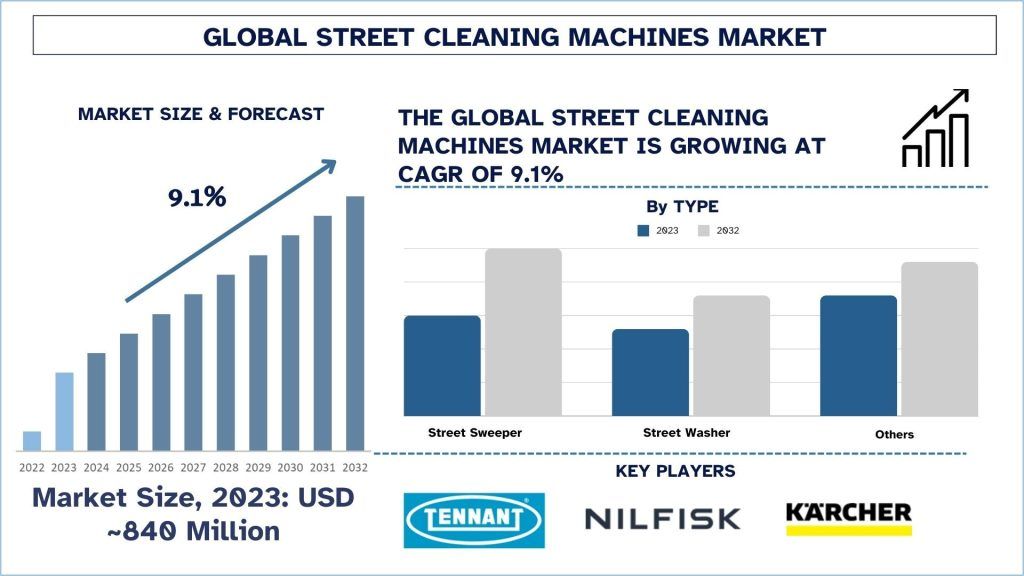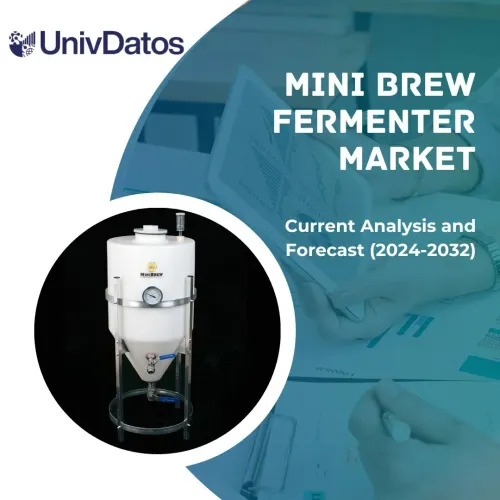- Home
- About Us
- Industry
- Services
- Reading
- Contact Us
Street Cleaning Machines Market: Current Analysis and Forecast (2024-2032)
Emphasis on Type (Street Sweeper, Street Washer, and Others); Product Type (Walk-Behind, Ride-On and Truck Mounted, Others); Mode of Operation (Electric, Manual and ICE, and Others); Application (Urban Road, Highway, Airport, Others); and Region/Country
Street Cleaning Machines Market Size & Forecast
The Street Cleaning Machines market was valued at approximately USD 840 million in 2023 and is expected to grow at a substantial CAGR of around 9.1% during the forecast period (2024-2032) owing to the increasing urbanization.
Street Cleaning Machines Market Analysis
Street cleaning machines are specialized equipment designed to maintain the cleanliness of urban environments, including streets, sidewalks, and public spaces. These machines utilize a variety of technologies, such as brooms, brushes, vacuum systems, and water jets, to efficiently remove debris, dirt, litter, and pollutants. They come in various forms, including manual sweepers, ride-on machines, and fully automated units, each suited to different scales and types of cleaning tasks. These machines play a major role in ensuring urban hygiene, contributing to public health, and enhancing the aesthetic appeal of cities and towns.
Furthermore, companies are investing in advanced technologies such as automation, IoT integration, and electric power to meet the rising demand for efficient and eco-friendly cleaning solutions. On May 03, 2024, Tennant Company, a world leader in designing, manufacturing, and marketing solutions to reinvent how the world cleans, announced the launch of the Tennant-branded i-mop Lite and i-mop XL Plus scrubber products into the markets of Brazil, France, Portugal, and Spain. The i-mop is an innovative, mechanized solution providing a more effective and efficient cleaning in place of conventional mop-and-bucket cleaning. Additionally, the push for sustainability is prompting the development of machines that reduce emissions and energy consumption, aligning with global environmental goals. Additionally, the expansion into emerging markets presents new opportunities for market players. Moreover, public-private partnerships are becoming more common as governments seek to leverage private sector expertise and efficiency in large-scale urban cleaning projects.
Street Cleaning Machines Market Trends
This section discusses the key market trends influencing the various segments of the street cleaning machines market as identified by our research experts.
Electric Street Cleaning Machines Transforming Industry
The electric is expected to grow with a significant CAGR in the forecast period (2024-2032). This is mainly attributed to the enhanced focus on sustainability and minimizing carbon emissions. They are generally more environmentally friendly than diesel ones because they cause fewer emissions, are less noisy, and emit fewer air pollutants in urban areas. The developed battery technology, longer working hours, and lower maintenance costs increase the interest and sales of electric street cleaning machines to build a cleaner and environmentally friendly city infrastructure. For instance, in September 2022, Ideanomics, a global company focused on accelerating the commercial adoption of electric vehicles (EV), announced that its subsidiary, US Hybrid, is supplying Global Environmental Products (GEP) with its proprietary electric and hybrid electric propulsion kits for use in the construction of 62 zero emission street sweepers.
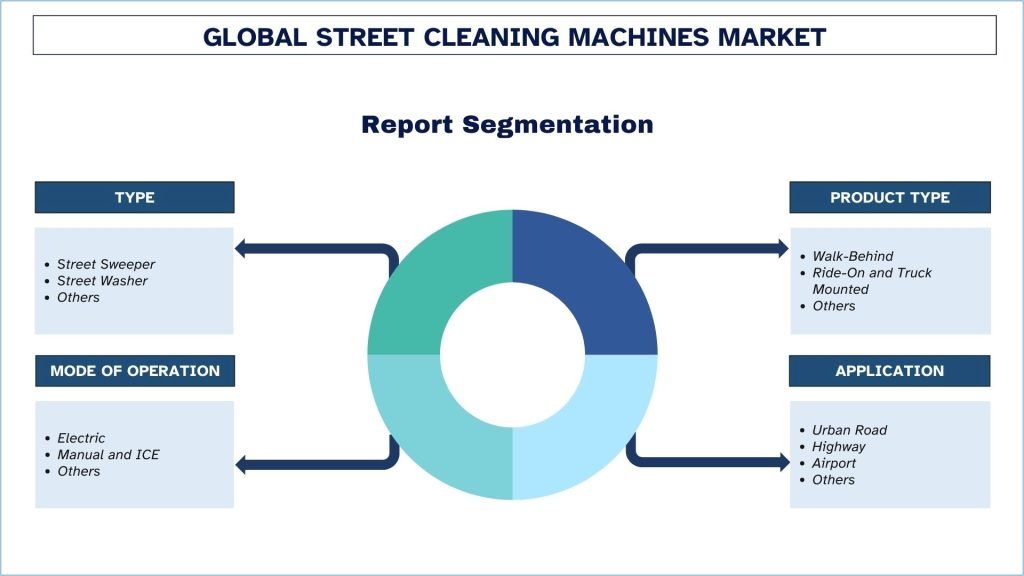
Europe leads the market in 2023
Europe dominates the street cleaning machines market owing to the stringent environmental regulations, strong emphasis on sustainability, and advanced urban infrastructure. European cities prioritize maintaining clean and aesthetically pleasing public spaces, leading to significant investments in modern street-cleaning equipment. In July 2023, Komatsu Europe announced its latest innovation, the PC33E-6 a new 3-ton class electric mini excavator equipped with a lithium-ion battery. Designed to set new standards in emission-free operation, with exceptional performance and unrivaled safety features, this cutting-edge new machine leads the way to a future of clean and caring practices and emission-free operation. The region’s focus on reducing carbon emissions has spurred the adoption of electric and hybrid street cleaning machines. Additionally, Europe’s commitment to smart city projects and innovative waste management solutions enhances the demand for high-tech street cleaning equipment. Major cities in countries like Germany, France, and the UK are at the forefront of implementing cutting-edge technologies to ensure efficient and eco-friendly street cleaning operations.
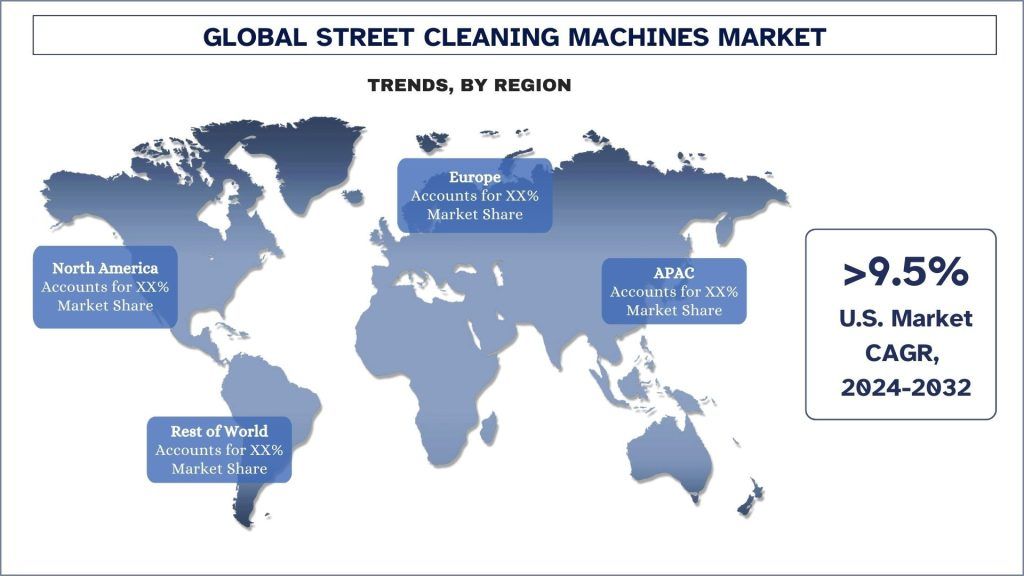
Street Cleaning Machines Industry Overview
The Street Cleaning Machines market is competitive, with several global and international players. The key players are adopting different growth strategies to enhance their market presence, such as partnerships, agreements, collaborations, new product launches, geographical expansions, and mergers and acquisitions. Some of the major players operating in the market are Tennant Company, Nilfisk Group, Alfred Kärcher SE & Co. KG, Dulevo, Aebi Schmidt Group, BUCHER, Hako GmbH, Elgin Sweeper Company, FAUN Umwelttechnik GmbH & Co. KG, Bortek Industries, Inc.
Street Cleaning Machines Market News
On May 15, 2024, Nilfisk, a leading global provider of professional cleaning products and services, launched the SC550 cleaning machine as a part of the company’s next generation of products. The SC550 uses 28% less energy than previous models, helping to lower emissions and create a cleaner and more resource-efficient future.
On May 03, 2024, Tennant Company, a world leader in designing, manufacturing, and marketing solutions to reinvent how the world cleans, announced the launch of the Tennant-branded i-mop Lite and i-mop XL Plus scrubber products into the markets of Brazil, France, Portugal, and Spain. The i-mop is an innovative, mechanized solution providing a more effective and efficient cleaning in place of conventional mop-and-bucket cleaning.
On April 25, 2024, Nilfisk launched an upgraded version of one of its best-selling vacuums. The new VP300 R consists of 30% PCR (Post-Consumer Recycled) plastic, closing the plastic products loop by diverting consumer waste from landfills. The new vacuum is the first Nilfisk product made from recycled consumer waste and marks the beginning of 2024 when Nilfisk introduces a range of both new and upgraded products during the year.
On March 01, 2023, Tennant Company announced that it has acquired M&F Management and Financing GmbH (“M&F”), the parent company of TCS EMEA GmbH (“TCS”), as Tennant seeks to accelerate growth in the EMEA region.
In September 2022, Ideanomics, a global company focused on accelerating the commercial adoption of electric vehicles (EV), announced that its subsidiary, US Hybrid, is supplying Global Environmental Products (GEP) with its proprietary electric and hybrid electric propulsion kits for use in the construction of 62 zero emission street sweepers.
On May 6, 2022, Elgin Sweeper, a leading global manufacturer of street sweepers, officially announced the new RegenX1. Once again utilizing the input of Elgin’s customers and Innovation Lab, the RegenX1 is a customer-driven design, mid-dump regenerative air street sweeper that is easy to use, clean and maintain.
On January 14, 2022, Bortek Industries, Inc. acquired Operating Assets of Carolina Industrial Equipment, Inc. CIE will operate as an independent entity as Carolina Industrial Equipment, LLC.
In February 2021, Tenax International designed and manufactured fully electric road sweepers and equipment, targeting rising municipal demand for an environmentally sustainable street cleaning on urban areas. Tenax full-electric vehicles are sold in over 40 countries and 80% of revenues are generated internationally.
Street Cleaning Machines Market Report Coverage
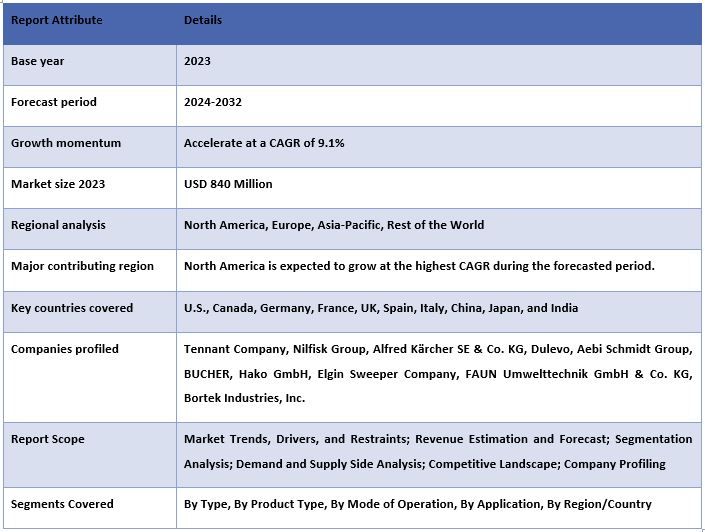
Reasons to buy this report:
- The study includes market sizing and forecasting analysis validated by authenticated key industry experts.
- The report presents a quick review of overall industry performance at one glance.
- The report covers an in-depth analysis of prominent industry peers with a primary focus on key business financials, product portfolios, expansion strategies, and recent developments.
- Detailed examination of drivers, restraints, key trends, and opportunities prevailing in the industry.
- The study comprehensively covers the market across different segments.
- Deep dive regional level analysis of the industry.
Customization Options:
The global street cleaning machines market can be customized further as per the requirement or any other market segment. Besides this, UMI understands that you may have your own business needs, hence feel free to connect with us to get a report that completely suits your requirements.
Table of Content
Research Methodology for the Street Cleaning Machines Market Analysis (2022-2032)
Analyzing the historical market, estimating the current market, and forecasting the future market of the global street cleaning machines market were the three major steps undertaken to create and analyze the adoption of street cleaning machines in major regions globally. Exhaustive secondary research was conducted to collect the historical market numbers and estimate the current market size. Secondly, to validate these insights, numerous findings and assumptions were taken into consideration. Moreover, exhaustive primary interviews were also conducted, with industry experts across the value chain of the global street cleaning machines market. Post assumption and validation of market numbers through primary interviews, we employed a top-down/bottom-up approach to forecasting the complete market size. Thereafter, market breakdown and data triangulation methods were adopted to estimate and analyze the market size of segments and sub-segments of the industry. Detailed methodology is explained below:
Analysis of Historical Market Size
Step 1: In-Depth Study of Secondary Sources:
A detailed secondary study was conducted to obtain the historical market size of the Street Cleaning Machines market through company internal sources such as annual reports & financial statements, performance presentations, press releases, etc., and external sources including journals, news & articles, government publications, competitor publications, sector reports, third-party database, and other credible publications.
Step 2: Market Segmentation:
After obtaining the historical market size of the street cleaning machines market, we conducted a detailed secondary analysis to gather historical market insights and share for different segments & sub-segments for major regions. Major segments are included in the report as type, product type, mode of operation, application, and regions. Further country-level analyses were conducted to evaluate the overall adoption of testing models in that region.
Step 3: Factor Analysis:
After acquiring the historical market size of different segments and sub-segments, we conducted a detailed factor analysis to estimate the current market size of the street cleaning machines market. Further, we conducted factor analysis using dependent and independent variables such as type, product type, mode of operation, application, and regions of the street cleaning machines market. A thorough analysis was conducted for demand and supply-side scenarios considering top partnerships, mergers and acquisitions, business expansion, and product launches in the street cleaning machines market sector across the globe.
Current Market Size Estimate & Forecast
Current Market Sizing: Based on actionable insights from the above 3 steps, we arrived at the current market size, key players in the global street cleaning machines market, and market shares of the segments. All the required percentage shares split, and market breakdowns were determined using the above-mentioned secondary approach and were verified through primary interviews.
Estimation & Forecasting: For market estimation and forecast, weights were assigned to different factors including drivers & trends, restraints, and opportunities available for the stakeholders. After analyzing these factors, relevant forecasting techniques i.e., the top-down/bottom-up approach were applied to arrive at the market forecast for 2032 for different segments and sub-segments across the major markets globally. The research methodology adopted to estimate the market size encompasses:
- The industry’s market size, in terms of revenue (USD) and the adoption rate of the Street Cleaning Machines market across the major markets domestically
- All percentage shares, splits, and breakdowns of market segments and sub-segments
- Key players in the global street cleaning machines market in terms of products offered. Also, the growth strategies adopted by these players to compete in the fast-growing market
Market Size and Share Validation
Primary Research: In-depth interviews were conducted with the Key Opinion Leaders (KOLs) including Top Level Executives (CXO/VPs, Sales Head, Marketing Head, Operational Head, Regional Head, Country Head, etc.) across major regions. Primary research findings were then summarized, and statistical analysis was performed to prove the stated hypothesis. Inputs from primary research were consolidated with secondary findings, hence turning information into actionable insights.
Split of Primary Participants in Different Regions
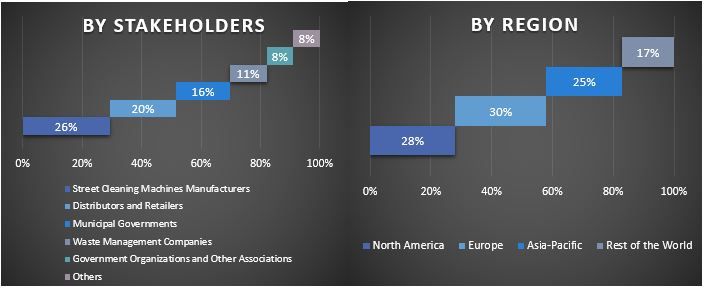
Market Engineering
The data triangulation technique was employed to complete the overall market estimation and to arrive at precise statistical numbers for each segment and sub-segment of the global street cleaning machines market. Data was split into several segments and sub-segments after studying various parameters and trends in the type, product type, mode of operation, application, and regions of the global Street Cleaning Machines market.
The main objective of the Global Street Cleaning Machines Market Study
The current & future market trends of the global Street Cleaning Machines market were pinpointed in the study. Investors can gain strategic insights to base their discretion for investments on the qualitative and quantitative analysis performed in the study. Current and future market trends determined the overall attractiveness of the market at a regional level, providing a platform for the industrial participant to exploit the untapped market to benefit from a first-mover advantage. Other quantitative goals of the studies include:
- Analyze the current and forecast market size of the street cleaning machines market in terms of value (USD). Also, analyze the current and forecast market size of different segments and sub-segments.
- Segments in the study include areas of the type, product type, mode of operation, application, and regions.
- Define and analyze the regulatory framework for the Street Cleaning Machines
- Analyze the value chain involved with the presence of various intermediaries, along with analyzing customer and competitor behaviors of the industry.
- Analyze the current and forecast market size of the Street Cleaning Machines market for the major region.
- Major countries of regions studied in the report include Asia Pacific, Europe, North America, and the Rest of the World
- Company profiles of the street cleaning machine market and the growth strategies adopted by the market players to sustain the fast-growing market.
- Deep dive regional level analysis of the industry
Frequently Asked Questions FAQs
Q1: What is the street cleaning machines market's current size and growth potential?
Q2: What are the driving factors for the growth of the street cleaning machines market?
Q3: Which segment has the largest share of the street cleaning machines market by type?
Q4: What are the major trends in the street cleaning machines market?
Q5: Which region will dominate the street cleaning machines market?
Related Reports
Customers who bought this item also bought

